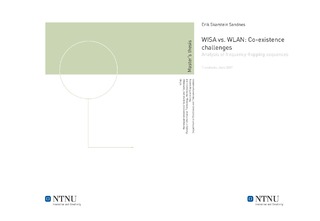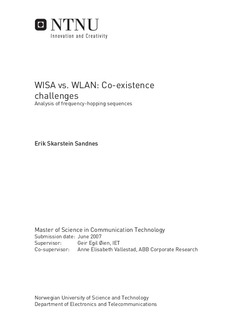| dc.contributor.advisor | Øien, Geir Egil | nb_NO |
| dc.contributor.author | Sandnes, Erik Skarstein | nb_NO |
| dc.date.accessioned | 2014-12-19T13:43:25Z | |
| dc.date.accessioned | 2015-12-22T11:40:56Z | |
| dc.date.available | 2014-12-19T13:43:25Z | |
| dc.date.available | 2015-12-22T11:40:56Z | |
| dc.date.created | 2010-09-03 | nb_NO |
| dc.date.issued | 2007 | nb_NO |
| dc.identifier | 347532 | nb_NO |
| dc.identifier.uri | http://hdl.handle.net/11250/2369097 | |
| dc.description.abstract | Wireless Interface for Sensors and Actuators (WISA) is ABB s proprietary wireless protocol for industrial automation. It operates in the 2.4 GHz ISM band, as do nearly allWireless LAN systems. WISA does frequency-hopping (FH) over most of the ISM band, but has currently no means of avoiding parts of the band occupied by other wireless systems. The objective of the diploma project was to create a Matlab based simulation tool that can (i) analyze cross-correlation between FH sequences in two closely spaced WISA cells, and (ii) generate new FH sequences which avoid a user-selectable portion of the frequency band. New frequency-hopping sequences were designed using Galois field computations for creating periodic sequences with minimum correlation. The developed Matlab simulation module did indeed meet the objectives. However the algorithm for subband-allocation is not optimal and will for some cases not give maximum utilization of the available frequency band. Analysis of the existing FH algorithm confirmed that some sequence pairs are non-ideal in the sense that their inevitable frequency collisions are not spread evenly over all relative shifts between the sequences, but concentrated to a few of these shifts. It was also pointed out that not all cell ids met the desired requirement of large separation between transmissions occurring on consecutive frames. Analysis of the new FH sequences, which avoid a user-selected portion of the frequency band, showed that these had many of the same properties as the existing algorithm. It was possible to find sequence pairs with low correlation and thus allow multiple cells to operate in the same radio space. | nb_NO |
| dc.language | eng | nb_NO |
| dc.publisher | Institutt for elektronikk og telekommunikasjon | nb_NO |
| dc.subject | ntnudaim | no_NO |
| dc.title | WISA vs. WLAN: Co-existence challenges: Analysis of frequency-hopping sequences | nb_NO |
| dc.type | Master thesis | nb_NO |
| dc.source.pagenumber | 89 | nb_NO |
| dc.contributor.department | Norges teknisk-naturvitenskapelige universitet, Fakultet for informasjonsteknologi, matematikk og elektroteknikk, Institutt for elektronikk og telekommunikasjon | nb_NO |

